By: Cary Smith
For many athletes, winter is the off season. This, of course, doesn’t mean sitting on the couch and losing all your hard-earned fitness from the summer. Rather, it means starting to rebuild so you can return faster and stronger next season. For many of us, this calls for bundling up and getting outside in the cold and dark. With this change in the weather comes a need for increased preparation of equipment, clothing and nutrition. Since I’m a skier and cyclist, I will focus on what I do for these activities but my ideas can easily be adapted to other sports.
Equipment preparation can be summarized with a simple saying I like to remind myself of whenever I don’t feel like waxing my skis or cleaning my bike: Take care of your gear and it will take care of you. In other words, stay on top of regular maintenance so that equipment failure doesn’t leave you stranded. This is especially necessary in winter since any unplanned extension of your workout can have dire consequences. For winter cycling, there are a few things you can do to make it more enjoyable. First, put fenders on your bike to stay dry so you can ride longer without getting as chilled. Second, have a good light system. Daylight is scarce and cars are not expecting bikes on the road when it’s cold, raining or snowing. Third, ride slower. I don’t mean easier, I mean use a mountain bike, cyclocross bike or fat bike. The wind generated while riding on the roads with 23mm slick tires will cool your core much faster than if you’re working harder to turn larger, heavier tires while going slower.
Everybody has their own ideas on clothing choices that work for them. So, whatever works, stick with it. My rule of thumb is that I should feel chilly as I start my workout knowing that I will soon be warmed up. Try to avoid sweaty clothes, as they are the best way to drop your core temperature; wear layers that you can strip. Don’t underestimate the usefulness of a neck warmer. It takes very little space in your pocket or pack and almost acts as an extra layer. If you haven’t ridden with handcovers, or pogies, you’re missing out. You can stay warm with a much lighter glove, increasing dexterity and control.
Your nutrition requirements are slightly changed in cold temperature, as they are at high altitude, which often goes hand in hand with cold and winter sports. As the mercury plummets, your need for glycogen increases. Your body doesn’t like to burn fat when it’s cold since glucose, both ingested and stored as glycogen, is easier and faster to use. What this means is that you should eat a warm meal 2-3 hours prior to your workout-think oatmeal or pasta-and then plan on Gu and Chomps to top off your tank while training. The trick here is to keep your food as warm as possible. Try to avoid storing it in your pack but rather next to your body-in a pocket, in your glove or even stuffed in your lycra. This aids both in ease of consumption and ease of digestion as your body doesn’t need to expend energy keeping your body warm while you’re trying to freeze it from the inside out. One study found that fingertips were 2 degrees colder five minutes after eating a bowl of ice cream and 5 degrees colder after 15 minutes.
Dehydration is prevalent in winter athletes for a variety of reasons. As our core temperature drops, the desire to drink is diminished. And the lack of sweat (if you’re dressed properly) leads people to believe they don’t need to drink. Unfortunately, your body is still losing water as both sweat and through exhalation. As you breathe in cold, dry air, your body needs to warm and moisten it. This extra moisture is then lost every time you exhale. Obviously, the harder you’re breathing the more pronounced this is. So, you need to drink and you need carbohydrates. What’s the solution? Gu Brew or Roctane, depending on the length of your workout. Electrolytes are not as important in the winter since, hopefully, you’re not sweating as much due to proper clothing choices.
Again, internal cold is the enemy, so the warmer the liquid, the better it works. Always fill your bottle or hydration system with warm/hot drink mix. The insulated bottles work OK in moderate temperatures but they’re still helped by keeping them on your body in a jersey pocket or in your pack instead of on your bike. I like to use a hydration bladder over my first layer but under other layers in the form of a low profile pack or a vest with a sleeve. Then I can keep the hose inside as well. Speaking of hoses, after drinking your fill, blow the liquid back into the bladder to keep it from freezing in the (insulated) tube. Drinking often will help your performance as well as keep your container from freezing, rendering it useless.
Embrace the cold, just remember to prepare for it. It never hurts to bring a few more calories than you think you’ll need. It might be just enough to get you home when your phone is frozen and you can’t call for help!














